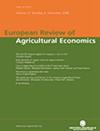从选择到语境:重新思考食品环境、消费者代理和政策行动
IF 3.5
2区 经济学
Q2 AGRICULTURAL ECONOMICS & POLICY
引用次数: 0
摘要
食品环境的传统衡量标准,如可获得性,通常以地理邻近性为中心,但在数字时代,邻近性不再是一个限制,因为消费者可以在网上浏览数千种食品选择。我将可用性的概念扩展到包括消费者在网上购买食品时看到的内容。我利用密歇根州优步(Uber Eats)从网上搜集的外卖食品数据,绘制出零售商的分布、产品种类和价格,并将它们与营养概况和碳排放联系起来。我发现数字食品环境被营养不均衡、热量密集和碳密集的选择所主导。当选择结构限制了可用的选择时,即使是具有强烈健康和可持续性偏好的个人也无法做出符合其饮食目标的选择。由于这些环境是由供给和需求决定的,因此需要采取双重政策策略来改革所提供、推广和定价的内容。本文章由计算机程序翻译,如有差异,请以英文原文为准。
From choice to context: Rethinking food environments, consumer agency and policy action
Traditional measures of food environments, such as availability, often center on geographic proximity, but in the digital era, proximity is less of a constraint, as consumers browse thousands of food options online. I extend the concept of availability to include what consumers see when buying food online. Using web-scraped data on food-away-from-home offerings from Uber Eats in Michigan, I map retailer presence, product offerings and prices, linking them to nutritional profiles and carbon emissions. I find that the digital food environment is dominated by nutritionally unbalanced, calory-dense and carbon-intensive options. When choice architecture constrains available options, even individuals with strong health and sustainability preferences are unable to make choices aligned with their dietary goals. As these environments are shaped by supply and demand, dual policy strategies are needed to reform what is offered, promoted and priced.
求助全文
通过发布文献求助,成功后即可免费获取论文全文。
去求助
来源期刊

European Review of Agricultural Economics
管理科学-农业经济与政策
CiteScore
6.60
自引率
5.90%
发文量
25
审稿时长
>24 weeks
期刊介绍:
The European Review of Agricultural Economics serves as a forum for innovative theoretical and applied agricultural economics research.
The ERAE strives for balanced coverage of economic issues within the broad subject matter of agricultural and food production, consumption and trade, rural development, and resource use and conservation. Topics of specific interest include multiple roles of agriculture; trade and development; industrial organisation of the food sector; institutional dynamics; consumer behaviour; sustainable resource use; bioenergy; agricultural, agri-environmental and rural policy; specific European issues.
Methodological articles are welcome. All published papers are at least double peer reviewed and must show originality and innovation. The ERAE also publishes book reviews.
 求助内容:
求助内容: 应助结果提醒方式:
应助结果提醒方式:


